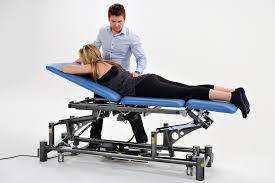Introduction:
In the dynamic realm of healthcare, the significance of proper equipment cannot be overstated. Among the essential fixtures, therapy tables play a pivotal role in ensuring both patient comfort and effective treatment. In this comprehensive guide, we delve into the various types of therapy tables, the art of choosing the right one, and the manifold benefits they offer to healthcare professionals and patients alike.
Types of Types of Therapy Tables
There are many types of Therapy Tables some of which are In following:
- Massage Tables:
- Designed for massage therapy sessions.
- Typically padded for comfort.
- Adjustable height to accommodate different therapists and client preferences.
- Physical Therapy Tables:
- Specifically designed for physical therapy exercises and treatments.
- May include features like adjustable sections, traction, or tilting capabilities.
- Chiropractic Tables:
- Tailored for chiropractic adjustments and treatments.
- Often have adjustable sections and features to support spinal manipulations.
- Examination Tables:
- Used in medical settings for general examinations and evaluations.
- Usually have a flat, cushioned surface with adjustable height.
- Rehabilitation Tables:
- Designed for rehabilitation exercises and activities.
- Often equipped with features like straps, supports, and adjustable sections.
- Occupational Therapy Tables:
- Geared towards occupational therapy interventions.
- May have adjustable height and features to support various activities.
- Tilt Tables:
- Used for tilt table testing or therapy.
- Can be tilted to different angles to assist with specific therapeutic goals.
- Exam Table:
- Versatile Design: Exam tables serve as essential fixtures in medical examination rooms, offering a flexible solution for a range of examinations.
- Comfortable and Adjustable: Designed to provide a comfortable and adjustable surface, these tables support routine check-ups, consultations, and minor medical procedures for patients.
- Mat Tables:
- Low tables are designed for therapies conducted on mats.
- Suitable for activities where clients need to be closer to the ground.
- Gynecologist Table:
- Gynecologist tables designed for women’s health exams with adjustable features and specialized stirrups.
- Ensures optimal positioning, promoting comfort and accessibility for healthcare practitioners during gynecological exams.
Choosing the Right Therapy Table
Selecting the appropriate therapy table is a nuanced process that involves considering various factors. Healthcare providers must assess the specific needs of their practice and patient population. Factors to consider include:
- Functionality: Ensuring the table serves the intended purpose efficiently.
- Adjustability: Opting for tables with customizable features for diverse patient requirements.
- Durability: Investing in tables constructed with high-quality materials for long-lasting use.
- Hygiene and Maintenance: Choosing tables that facilitate easy cleaning and maintenance for infection control.
Benefits of Therapy Tables
- Enhanced Patient Comfort: Therapy tables are designed with patient comfort in mind, featuring padded surfaces and ergonomic designs that alleviate discomfort and anxiety during medical examinations or treatments.
- Facilitated Medical Procedures: Whether it’s a routine check-up or a specialized medical procedure, therapy tables provide a stable and adjustable platform, optimizing the ease with which healthcare professionals can perform their tasks.
- Improved Accessibility: Specialized tables, such as gynecologist tables, enhance accessibility for both patients and healthcare practitioners, ensuring examinations are conducted with precision and care.
- Efficient Patient Transport: Gurney beds streamline the process of patient transport within healthcare facilities, promoting efficiency and reducing the risk of injurie
- gynecologist table
- s for both patients and healthcare staff.
Conclusion
In conclusion, therapy tables are indispensable assets in the healthcare landscape. From gurney beds facilitating seamless patient transport to exam tables providing versatile examination solutions, and gynecologist tables catering to the unique needs of women’s health, the right therapy table can significantly impact the quality of patient care. By carefully considering the specific requirements of their practice, healthcare providers can choose tables that not only meet their needs but also contribute to an environment of enhanced patient well-being and comfort. As the healthcare industry continues to evolve, the role of therapy tables in delivering optimal care remains steadfast.




